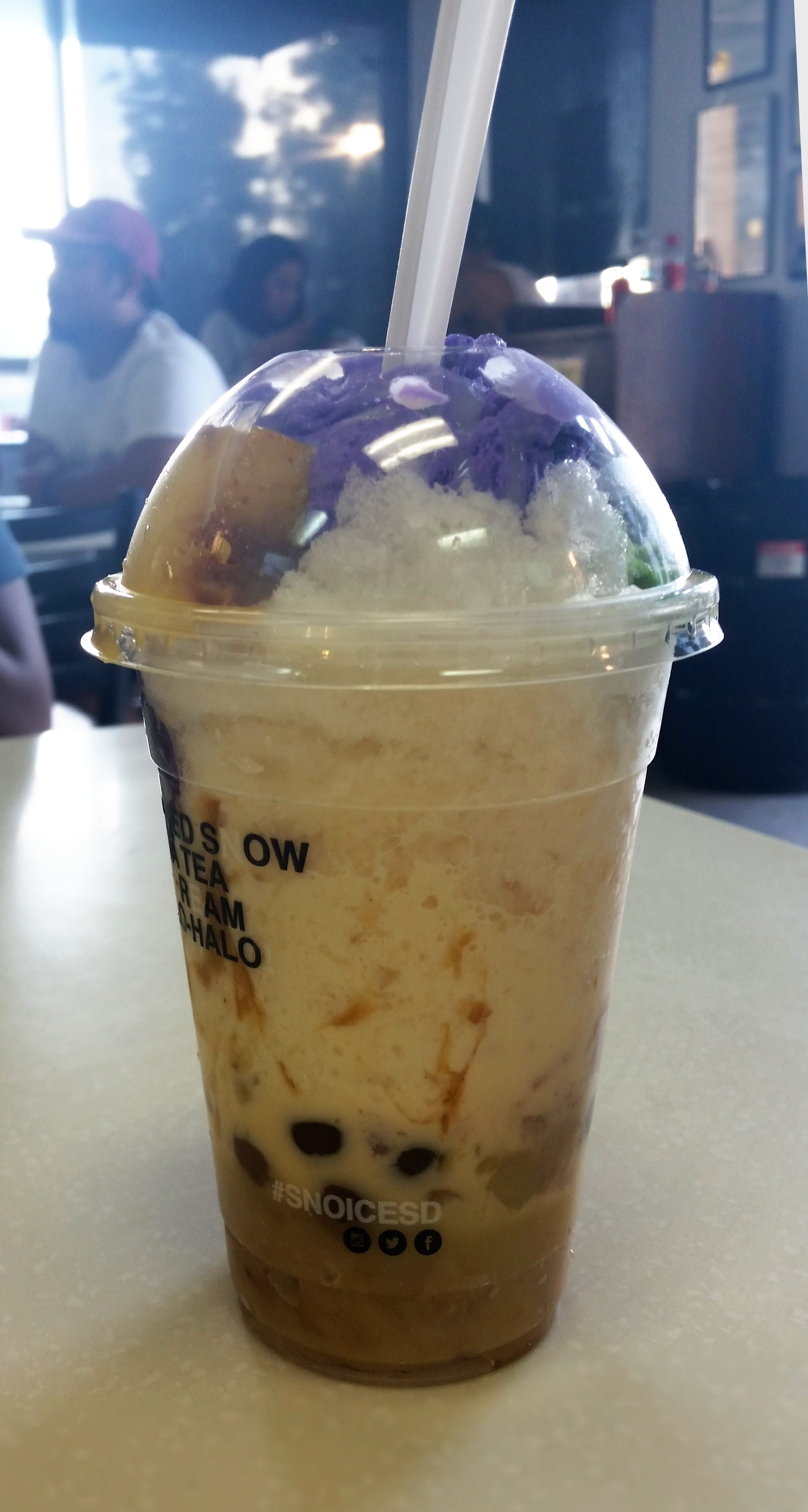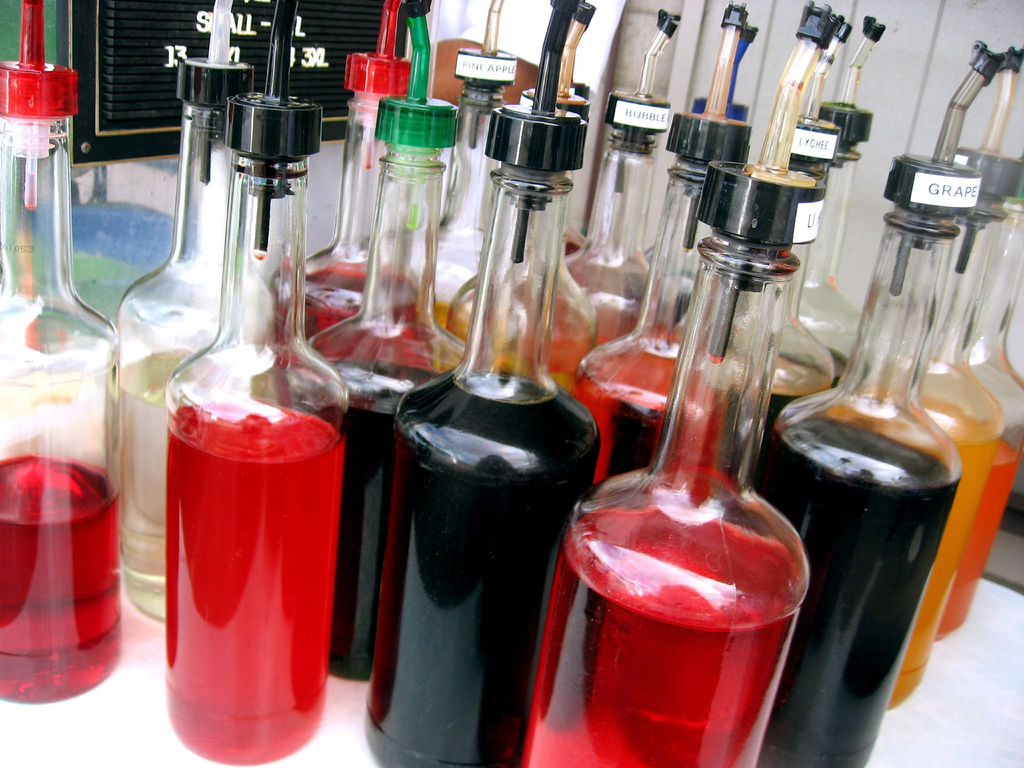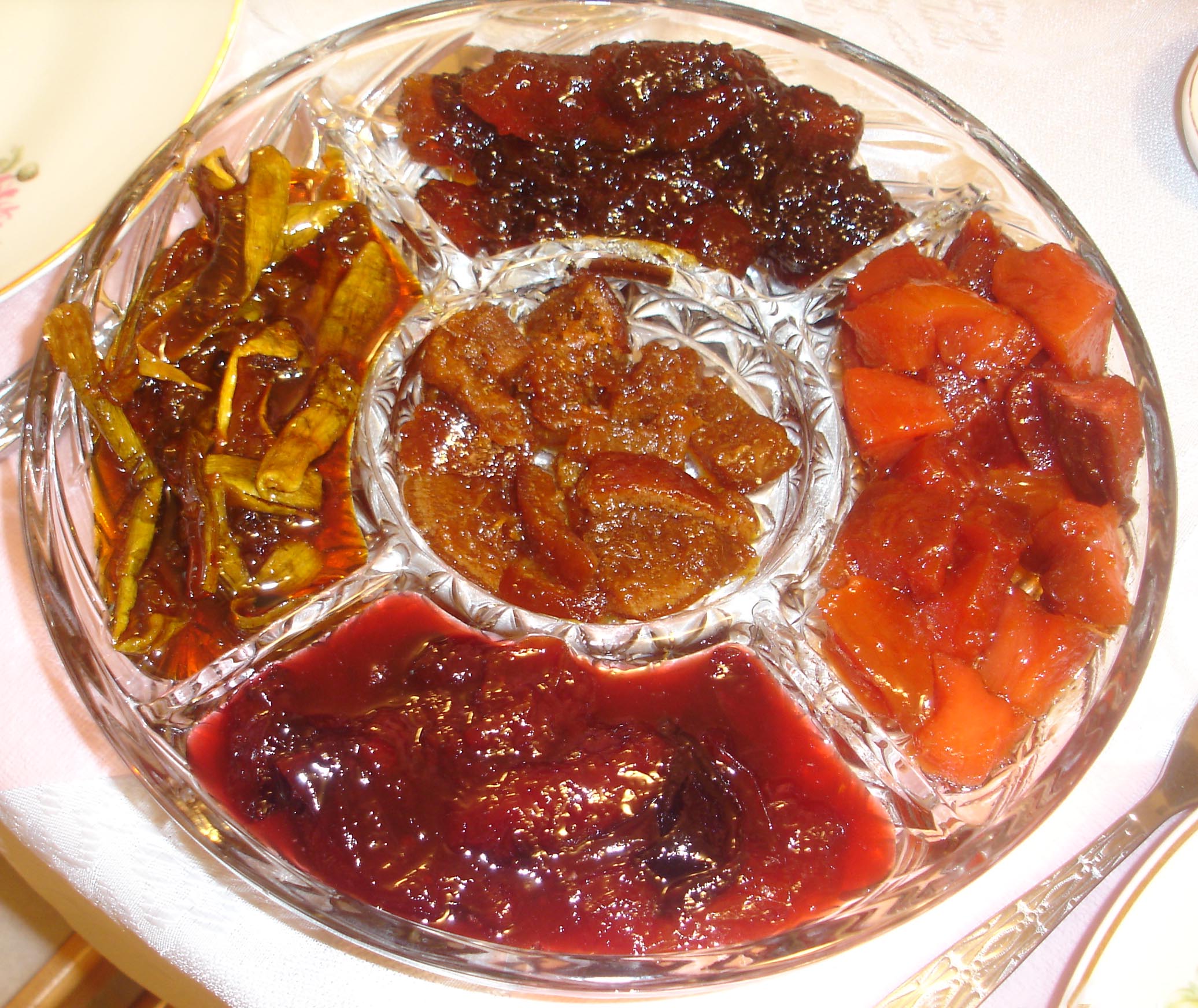|
Halo-halo
Halo-halo, correctly spelled ''haluhalo'', Tagalog for "mixed" (the more common spelling instead literally equating to "mix-mix") is a popular cold dessert in the Philippines made up of crushed ice, evaporated milk or coconut milk, and various ingredients including ube jam ( ube halaya), sweetened kidney or garbanzo beans, coconut strips, sago, '' gulaman'' (agar), pinipig, boiled taro or soft yams in cubes, flan, slices or portions of fruit preserves and other root crop preserves. The dessert is topped with a scoop of ube ice cream. It is usually prepared in a tall clear glass and served with a long spoon. ''Halo-halo'' is considered to be the unofficial national dessert of the Philippines. The term "''halo-halo''" is supposed to mean "mixed" in English because the dessert is meant to be mixed before being consumed. Although strictly grammatically incorrect, this spelling has come to describe any object or situation composed of a similar, colorful combination of i ... [...More Info...] [...Related Items...] OR: [Wikipedia] [Google] [Baidu] |
Shaved Ice
Shaved ice is a large family of ice-based desserts made of fine shavings of ice or finely crushed ice and sweet condiments or syrups. Usually, the syrup is added after the ice has been frozen and shaved—typically at the point of sale; however, flavoring can also be added before freezing. The dessert is consumed worldwide in various forms and ways. Shaved ice can also be mixed with large quantities of liquid to produce shaved ice drinks. Many shaved ices are confused with " Italian ice", which is derived from the similar Italian dessert known as " granita". However, Italian ice, also known as "water ice", often has the flavoring (fruit juice or other ingredients, like almond) incorporated into the sugared water before it is frozen. Shaved ice—especially highly commercial shaved ice (such as that found in food chains or from street vendors)—is often flavored after the ice has been frozen and shaved. Snow cones are an example of shaved ice that is flavored after production. H ... [...More Info...] [...Related Items...] OR: [Wikipedia] [Google] [Baidu] |
Kakigōri
is a Japanese shaved ice dessert flavored with syrup and a sweetener, often condensed milk.新明解国語辞典(第6版)、三省堂 History The origins of ''kakigōri'' date back to the Heian period in Japanese history, when blocks of ice saved during the colder months would be shaved and served with sweet syrup to Japanese aristocracy during the summer. Kakigōri's origin is referred to in ''The Pillow Book'', a book of observations written by Sei Shōnagon, who served the Imperial Court during the Heian period. Kakigōri became more accessible in the 19th century, when ice became more widely available to the public during the summertime. The first kakigōri store is believed to have opened in Yokohama in 1869. July 25 is known as kakigōri day in Japan because of its pronunciation sounding similar to summer ice in Japanese. Another reasoning for July 25 being kakigōri day is because, on that day in 1933, there was a record high temperature in Japan. Description The t ... [...More Info...] [...Related Items...] OR: [Wikipedia] [Google] [Baidu] |
Purple Yam
''Dioscorea alata'', also known as purple yam, ube (, ), or greater yam, among many other names, is a species of yam (a tuber). The tubers are usually a vivid violet-purple to bright lavender in color (hence the common name), but some range in color from cream to plain white. It is sometimes confused with taro and the Okinawa sweet potato (''Ipomoea batatas'' cv. Ayamurasaki), although ''D. alata'' is also grown in Okinawa, where it is known as . With its origins in the Asian tropics, ''D. alata'' has been known to humans since ancient times. Names Because it has become naturalized following its origins in Asia, specifically the Philippines, through tropical South America, and the southeastern U.S., ''D. alata'' is referred to by many different names in these regions. In English alone, aside from purple yam, other common names include ten-months yam, water yam, white yam, winged yam, violet yam, Guyana arrowroot, or simply yam. History of cultivation ''Dioscorea alata'' i ... [...More Info...] [...Related Items...] OR: [Wikipedia] [Google] [Baidu] |
Macapuno
Macapuno or coconut sport is a naturally occurring coconut cultivar which has an abnormal development of the endosperm. The result of this abnormal development is a soft translucent jelly-like flesh that fills almost the entire central cavity of coconut seeds, with little to no coconut water. Macapuno was first described scientifically from wild specimens in 1931 by Edwin Copeland. They were cultivated commercially in the Philippines after the development of the "embryo rescue" ''in vitro'' culture technology in the 1960s by Emerita V. De Guzman. It has become an important crop in coconut-producing countries and is now widely used in the cuisines of Southeast Asia and the Pacific Islands. Name The name ''macapuno'' (also spelled ''makapuno'') is derived from Tagalog , the local name of the phenotype in the Philippines, meaning "characterized by being full", a reference to the way the endosperm in macapuno coconuts fill the interior hollow of coconut seeds. In Indonesia, the na ... [...More Info...] [...Related Items...] OR: [Wikipedia] [Google] [Baidu] |
Ube Ice Cream
Ube ice cream is a Filipino ice cream flavor prepared using ube (purple yam) as the main ingredient. This ice cream is often used in making the dessert halo-halo. History Due to its vivid violet color and mildly sweet and nutty taste, ube has been a staple of Filipino desserts, most notably ube halaya. The earliest recorded use of ube in ice cream was in a recipe from 1922, when ice cream's introduction to Filipino culture during the American occupation (as the local adaptation sorbetes) led to new flavors such as mango, pinipig and melon. The recipe called for mashed ube, milk, sugar and crushed ice. During that time, ice cream was also hand-churned in a ''garapinyera'', a manually operated ice cream mixer. Ube ice cream has risen in popularity outside the Philippines, due to its use by Filipino immigrants in restaurants (often with halo-halo) and Trader Joe's line of ube products, its vivid violet color and the spread of its pictures on social media. Use in halo-halo ... [...More Info...] [...Related Items...] OR: [Wikipedia] [Google] [Baidu] |
Leche Flan
{{disambiguation ...
Leche (Spanish: "milk") may refer to: * Leche (surname) * ''Leche'' (Fobia album), 1993 * ''Leche'' (Illya Kuryaki and the Valderramas album), 1999 * ''Leche'', a 2010 album by Gregory and the Hawk * Leche frita, a Spanish sweet See also * Laguna de Leche, the largest natural fresh water lake in Cuba * Lech (other) Lech may refer to: People * Lech (name), a name of Polish origin * Lech, the legendary founder of Poland * Lech (Bohemian prince) Products and organizations * Lech (beer), Polish beer produced by Kompania Piwowarska, in Poznań * Lech Poznań ... [...More Info...] [...Related Items...] OR: [Wikipedia] [Google] [Baidu] |
Fruit Preserves
Fruit preserves are preparations of fruits whose main preserving agent is sugar and sometimes acid, often stored in glass jars and used as a condiment or spread. There are many varieties of fruit preserves globally, distinguished by the method of preparation, type of fruit used, and place in a meal. Sweet fruit preserves such as jams, jellies, and marmalades are often eaten at breakfast with bread or as an ingredient of a pastry or dessert, whereas more savory and acidic preserves made from " vegetable fruits" such as tomato, squash or zucchini, are eaten alongside savory foods such as cheese, cold meats, and curries. Techniques There are several techniques of making jam, with or without added water. One factor depends on the natural pectin content of the ingredients. When making jam with low pectin fruits like strawberries either high pectin fruit like orange can be added, or additional pectin in the form of pectin powder, citric acid or citrus peels. Often the fruit will ... [...More Info...] [...Related Items...] OR: [Wikipedia] [Google] [Baidu] |
American Colonization Of The Philippines
American(s) may refer to: * American, something of, from, or related to the United States of America, commonly known as the "United States" or "America" ** Americans, citizens and nationals of the United States of America ** American ancestry, people who self-identify their ancestry as "American" ** American English, the set of varieties of the English language native to the United States ** Native Americans in the United States, indigenous peoples of the United States * American, something of, from, or related to the Americas, also known as "America" ** Indigenous peoples of the Americas * American (word), for analysis and history of the meanings in various contexts Organizations * American Airlines, U.S.-based airline headquartered in Fort Worth, Texas * American Athletic Conference, an American college athletic conference * American Recordings (record label), a record label previously known as Def American * American University, in Washington, D.C. Sports teams Soccer * ... [...More Info...] [...Related Items...] OR: [Wikipedia] [Google] [Baidu] |
Japanese In The Philippines
Japanese settlement in the Philippines or Japanese Filipino, refers to one of the largest branches of Japanese diaspora having historical contact with and having established themselves in what is now the Philippines. This also refers to Filipino citizens of either pure or mixed Japanese descent currently residing in the country, the latter a result of intermarriages between the Japanese and local populations. History Classical period Settlements After the establishment of a single state within Japan, official trade records began between Japan and the Philippine islands in the Heian and Muromachi period (8th to 12th centuries CE). In the case of the proto-Okinawan chiefdoms, this was much earlier, and ties in with shared migration patterns of Okinawans and Austronesian areas like the Philippines stretching back to the neolithic period. Notable settlements of the period include Bolinao and Agoo along Lingayen Gulf. The Japanese were trading with Philippine kingdoms well before ... [...More Info...] [...Related Items...] OR: [Wikipedia] [Google] [Baidu] |
Philippines
The Philippines (; fil, Pilipinas, links=no), officially the Republic of the Philippines ( fil, Republika ng Pilipinas, links=no), * bik, Republika kan Filipinas * ceb, Republika sa Pilipinas * cbk, República de Filipinas * hil, Republika sang Filipinas * ibg, Republika nat Filipinas * ilo, Republika ti Filipinas * ivv, Republika nu Filipinas * pam, Republika ning Filipinas * krj, Republika kang Pilipinas * mdh, Republika nu Pilipinas * mrw, Republika a Pilipinas * pag, Republika na Filipinas * xsb, Republika nin Pilipinas * sgd, Republika nan Pilipinas * tgl, Republika ng Pilipinas * tsg, Republika sin Pilipinas * war, Republika han Pilipinas * yka, Republika si Pilipinas In the recognized optional languages of the Philippines: * es, República de las Filipinas * ar, جمهورية الفلبين, Jumhūriyyat al-Filibbīn is an archipelagic state, archipelagic country in Southeast Asia. It is situated in the western Pacific Ocean and consists of aro ... [...More Info...] [...Related Items...] OR: [Wikipedia] [Google] [Baidu] |
Taro
Taro () (''Colocasia esculenta)'' is a root vegetable. It is the most widely cultivated species of several plants in the family Araceae that are used as vegetables for their corms, leaves, and petioles. Taro corms are a food staple in African, Oceanic, and South Asian cultures (similar to yams). Taro is believed to be one of the earliest cultivated plants. Names and etymology The English term '' taro'' was borrowed from the Māori language when Captain Cook first observed ''Colocasia'' plantations there in 1769. The form ''taro'' or ''talo'' is widespread among Polynesian languages:*''talo'': taro (''Colocasia esculenta'') – entry in the ''Polynesian Lexicon Project Online'' (Pollex). in Tahitian; ... [...More Info...] [...Related Items...] OR: [Wikipedia] [Google] [Baidu] |
Mung Bean
The mung bean (''Vigna radiata''), alternatively known as the green gram, maash ( fa, ماش٫ )٫ mūng (), monggo, or munggo (Philippines), is a plant species in the legume family.Brief Introduction of Mung Bean. Vigna Radiata Extract Green Mung Bean Extract Powder Phaseolus aureus Roxb Vigna radiata L R Wilczek. MDidea-Extracts Professional. P054. http://www.mdidea.com/products/proper/proper05402.html The mung bean is mainly cultivated in East, Southeast and South Asia. It is used as an ingredient in both savoury and sweet dishes. Description The green gram is an annual vine with yellow flowers and fuzzy brown pods. The English word ''mung'' originated from the Hindi word (), which is derived from the Sanskrit word (). Morphology Mung bean (''Vigna radiata'') is a plant species of Fabaceae which is also known as green gram. It is sometimes confused with black gram (''Vigna mungo'') for their similar morphology, though they are two different species. The g ... [...More Info...] [...Related Items...] OR: [Wikipedia] [Google] [Baidu] |



.jpg)

